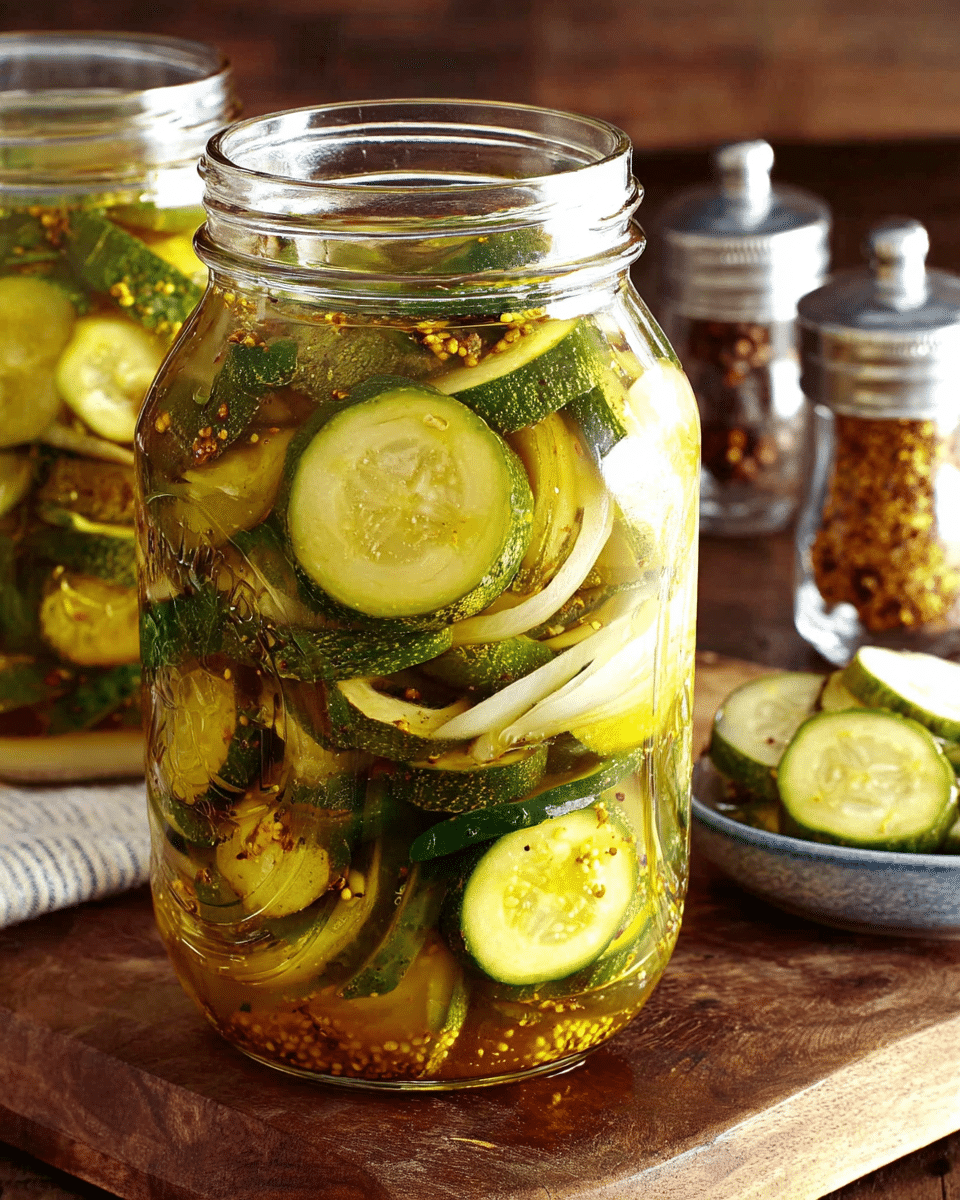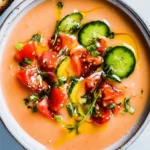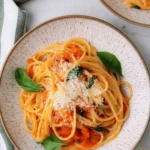Bread and butter pickles are a classic refrigerator pickle known for their perfect balance of sweetness and tang, with just the right crunch. Unlike traditional canned pickles, this quick version doesn’t require long fermentation or a water bath. They’re perfect for making in small batches and storing in the fridge. Ideal for burgers, sandwiches, or snacking straight from the jar, these pickles offer a flavorful punch that elevates everyday meals with minimal effort and maximum reward.
FULL RECIPE
Ingredients
- 4 cups sliced pickling cucumbers (about 4–5 small cucumbers)
- 1 medium onion, thinly sliced
- 1 tablespoon kosher salt
- 1 cup distilled white vinegar
- 1/2 cup apple cider vinegar
- 3/4 cup granulated sugar
- 1/4 cup light brown sugar
- 1 teaspoon mustard seeds
- 1/2 teaspoon celery seeds
- 1/2 teaspoon ground turmeric
- 1/4 teaspoon crushed red pepper flakes (optional, for mild heat)
- 1/4 teaspoon ground cloves (optional, for added depth)
Directions
- Prep Cucumbers and Onions: In a large mixing bowl, toss the sliced cucumbers and onions with kosher salt. Let sit for 1 hour to draw out excess moisture. Afterward, rinse thoroughly and drain well.
- Sterilize Jars (Optional but Recommended): If storing longer, sterilize two pint-sized jars by boiling them in water for 10 minutes, then let them air dry.
- Prepare Pickling Brine: In a medium saucepan, combine white vinegar, apple cider vinegar, granulated sugar, brown sugar, mustard seeds, celery seeds, turmeric, red pepper flakes (if using), and ground cloves. Bring the mixture to a boil over medium heat, stirring until sugars dissolve completely.
- Pack Jars: Divide the drained cucumber and onion slices evenly between the jars.
- Add Brine: Carefully pour the hot brine over the vegetables, ensuring they are fully submerged. Tap the jars gently to release any trapped air bubbles.
- Cool and Chill: Let jars cool to room temperature with the lids slightly ajar. Once cooled, seal tightly and refrigerate for at least 24 hours before using for best flavor.
- Store: These pickles are best enjoyed within 2 weeks and will keep in the refrigerator for up to 1 month.
Nutrition Facts
- Calories: 45
- Total Fat: 0g
- Saturated Fat: 0g
- Trans Fat: 0g
- Cholesterol: 0mg
- Sodium: 280mg
- Total Carbohydrates: 11g
- Dietary Fiber: 1g
- Sugars: 10g
- Protein: 0g
- Vitamin A: 2% DV
- Vitamin C: 6% DV
- Calcium: 2% DV
- Iron: 2% DV
Flavor Profile and Texture
What sets bread and butter pickles apart is their complex flavor—simultaneously sweet, tangy, and mildly spiced. The sweetness comes from a mix of granulated and brown sugars, while the tang is derived from vinegar. Ground turmeric adds a subtle warmth and rich golden hue, and spices like mustard seed, celery seed, and cloves introduce layers of aromatic depth. Thinly sliced cucumbers retain a delightful crunch, especially when not overcooked, making each bite satisfying both in taste and texture. The inclusion of onion slices enhances both flavor and bite, giving these pickles a multi-dimensional appeal.
Health Benefits of Quick Pickles
Although pickles are often seen as a garnish, they can offer surprising health benefits. Cucumbers are low in calories and a good source of hydration, thanks to their high water content. When quick-pickled, they retain much of their raw nutrient profile, including vitamin K and some fiber. Apple cider vinegar, often used in pickling, may aid in digestion and blood sugar control. Unlike fermented pickles, these quick versions don’t contain probiotics, but they are free from artificial preservatives and are easy to customize with wholesome ingredients, making them a smarter snacking choice.
Quick Pickling vs. Traditional Canning
Quick pickling, also known as refrigerator pickling, is an excellent technique for beginners or those who want fast results without the complexity of traditional canning. There’s no need for a water bath or pressure canner—just a hot brine and refrigerator storage. While quick pickles don’t have the shelf stability of canned versions, they make up for it in convenience and freshness. The method preserves the crispness of the vegetables and allows for experimentation with spices and flavors. It’s ideal for small batches, seasonal produce, and last-minute condiments.
Creative Variations to Try
Bread and butter pickles are highly adaptable and welcome a range of creative tweaks. For extra heat, jalapeños or red chili flakes can be added to the brine. If you’re avoiding refined sugars, try using honey, agave, or coconut sugar for a natural sweetness. Adding sliced bell peppers, carrots, or even radishes introduces color and additional crunch. A more savory twist can include garlic cloves or a splash of soy sauce for umami. Experimenting with different vinegar bases—like rice vinegar or white wine vinegar—can also subtly shift the flavor profile.
Serving Ideas and Pairings
Bread and butter pickles are more than just a side—they can enhance a wide range of dishes. Add them to sandwiches, burgers, or wraps for a refreshing contrast to rich meats or creamy sauces. Chop them up and stir into tuna salad, egg salad, or potato salad for extra zip. They also pair wonderfully with charcuterie boards, barbecue plates, or grilled cheese sandwiches. Their sweet-tangy flavor complements smoky, spicy, or savory dishes, offering a bright counterpoint that enlivens the entire meal. Even served solo as a snack, they’re hard to resist.
Storage and Shelf Life
These quick pickles are designed for refrigerator storage and are best consumed within a month for optimal flavor and texture. Always let the jars cool to room temperature before sealing and chilling to prevent condensation, which can affect quality. Use clean utensils to retrieve pickles from the jar to avoid introducing bacteria. While the pickles may still be safe to eat after a month, they will gradually lose their crispness and vibrancy. For best results, keep them tightly sealed in glass jars and store them in the coldest part of your refrigerator.
Kid-Friendly and Allergen-Free
Bread and butter pickles are naturally vegan, gluten-free, and nut-free, making them an accessible choice for a wide range of dietary needs. Their mild spice level and sweet edge often appeal to children, especially when served with familiar foods like sandwiches or hot dogs. You can easily adjust the sugar or omit optional spices to suit your family’s taste. They are a great way to introduce kids to new textures and flavors without overwhelming their palate. Plus, making pickles at home is a fun kitchen activity for families to enjoy together.
Sustainability and Reducing Food Waste
Quick pickling is a sustainable solution for using up cucumbers and other perishable produce before they spoil. If you grow your own vegetables or shop at farmers’ markets, pickling ensures nothing goes to waste. Even imperfect or slightly overripe cucumbers can be transformed into tasty pickles. Additionally, leftover brine can be reused to pickle other vegetables like red onions, green beans, or cauliflower. This method encourages resourcefulness and helps reduce food waste in both home and restaurant kitchens, contributing to more environmentally friendly cooking habits.
How to Customize for Special Diets
This recipe can be modified to fit special dietary preferences without sacrificing flavor. For low-sodium diets, reduce the salt and use a salt substitute if necessary. Diabetics or those on sugar-restricted diets can use sugar alternatives like monk fruit sweetener, stevia, or erythritol, though the flavor may vary slightly. Vinegar options can also be tailored for those with sensitivities; for example, rice vinegar is often milder and easier on the stomach. With careful adjustments, these pickles can fit into many eating plans, from paleo to Whole30 to low-FODMAP.
Advertisement
Conclusion
Quick bread and butter pickles offer the perfect combination of convenience, flavor, and versatility. From their sweet-tangy taste to their delightful crunch, they provide a refreshing contrast to savory dishes and serve as a bright accent on any plate. Their ease of preparation makes them ideal for home cooks of all levels, and their adaptability ensures they fit into a wide variety of diets and meals. Whether you’re making them for sandwiches, salads, or snacking straight from the jar, these pickles are a timeless classic reimagined for the modern kitchen.






